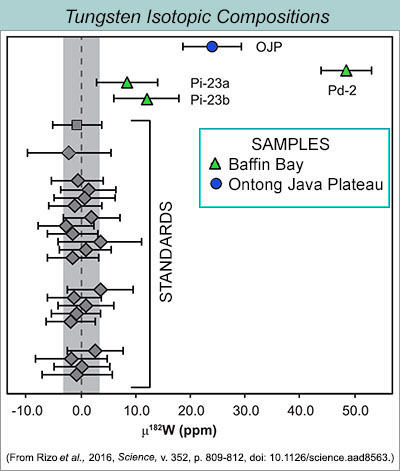Quick Views of Big Advances
Remnants of Earth's Construction
The compositions of the rocky planets and the Moon contain detailed though somewhat encoded records of their construction from a diverse set of planetesimals early in the history of our Solar System. The details are recorded in chemical and isotopic compositions of distinctive chemical reservoirs. Hanika Rizo (University of Quebec, Canada) and colleagues at the University of Maryland, Carnegie Institution of Washington, University of California, Davis and Santa Cruz, and McGill University made high-precision measurements of tungsten isotopes in rocks from Baffin Island, Canada, and the huge Ontong Java Plateau in the South Pacific.
 |
Deviation of the 182W/184W ratio in Baffin Island and Ontong Java basalts from the ratio in standards, which represent the bulk silicate Earth. The data are given in parts per million and abbreviated µ182W. The gray shaded region is the mean Earth plus or minus two standard deviations. Error bars are two-standard-deviation analytical uncertainty. Baffin Island and Ontong Java basalts have excesses in µ182W ranging from 10 to 48 parts per million, way outside analytical uncertainties. |
These rocks are parts of flood basalt complexes and were known previously to be old and have 3He/4He and D/H (D stands for deuterium, or heavy hydrogen) suggestive of containing primitive material derived from the solar nebula. (See PSRD article: Primeval Water in the Earth.) Although relatively young lava flows, they are derived from mantle source regions that are ancient, >4.45 billion years old. Hanika Rizo and colleagues show that lava flows from these distinctive regions of the mantle have distinctly higher 182W (tungsten) compared to most samples of the Earth (see figure above). Because 182Hf (hafnium) decays to 182W, the high 182W values indicate that these special regions inside Earth formed with high Hf/W ratios. This is important because it means that these regions formed early (182Hf has a half-life of only 8.9 million years), during the first 50 million years of Solar System history and probably even before the Moon formed by a giant impact near the end of Earth's construction.
It is amazing and fortunate that volumes of Earth's rocky mantle remained isolated from all the interior melting, convection, and recycling that are hallmarks of the geologically dynamic Earth. It gives some confidence in the inference from Martian meteorite isotopic analyses that distinctive regions formed inside Mars and remained isolated from 4.5 billion years until they began to produce basalts beginning 500 million years ago (see PSRD article: The Multifarious Martian Mantle).
![]() (pdf version)
(pdf version)
See Reference:
· Rizo, H., Walker, R. J., Carlson, R. W., Horan, M. F., Mukhopadhyay, S., Manthos, V., Francis, D., and Jackson, M. G. (2016) Preservation of Earth-forming Events in the Tungsten Isotopic Composition
of Modern Flood Basalts, Science, v. 352, p. 809-812, doi: 10.1126/science.aad8563. [ abstract ]
See also:
· Dahl, T. W. (2016) Identifying Remnants of Early Earth, Science, v. 352, p. 768-769, doi: 10.1126/science.aaf2482. [ summary ]
Written by G. Jeffrey Taylor, Hawai‘i Institute of Geophysics and Planetology, for PSRD.
|
|
[ About PSRD | Archive | CosmoSparks | Search | Subscribe ] [ Glossary | General Resources | Comments | Top of page ] |
